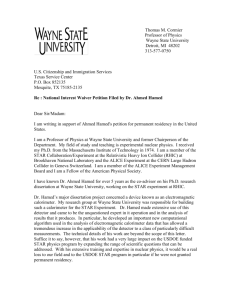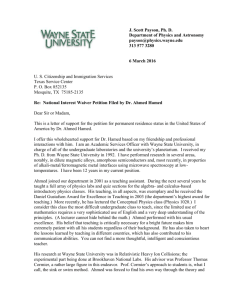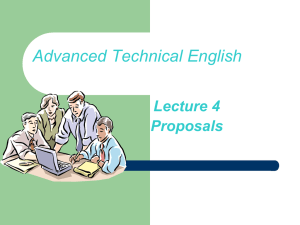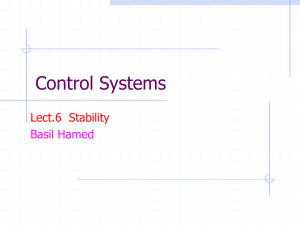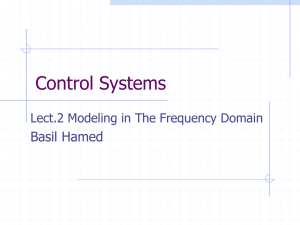Control Systems
advertisement
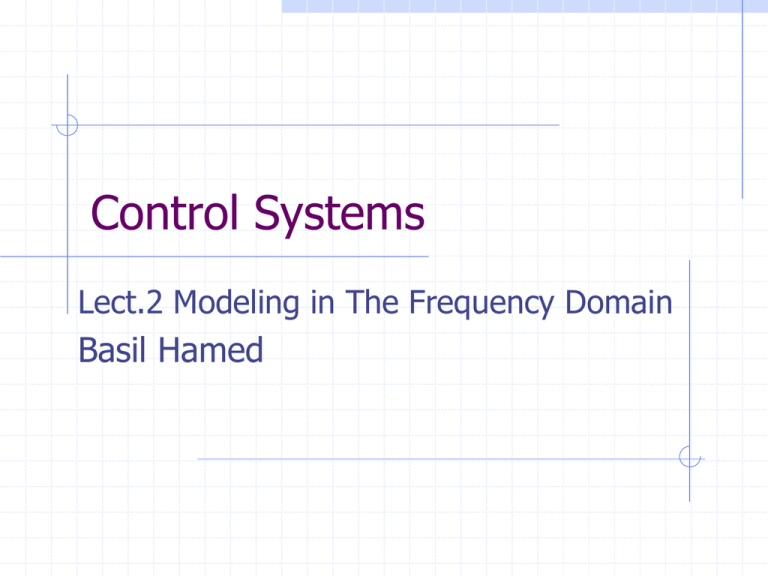
Control Systems Lect.2 Modeling in The Frequency Domain Basil Hamed Chapter Learning Outcomes • Find the Laplace transform of time functions and the inverse Laplace transform (Sections 2.1-2.2) • Find the transfer function from a differential equation and solve the differential equation using the transfer function (Section 2.3) • Find the transfer function for linear, time-invariant electrical networks (Section 2.4) • Find the transfer function for linear, time-invariant translational mechanical systems (Section 2.5) • Find the transfer function for linear, time-invariant rotational mechanical systems (Section 2.6) •Find the transfer function for linear, time-invariant electromechanical systems (Section 2.8) Basil Hamed 2 2.1 Introduction Basil Hamed 3 Mathematical Modelling To understand system performance, a mathematical model of the plant is required This will eventually allow us to design control systems to achieve a particular specification 2.2 Laplace Transform Review The defining equation above is also known as the onesided Laplace transform, as the integration is evaluated from t = O to ∞. Basil Hamed 5 Laplace Transform Review Laplace Table Basil Hamed 6 Laplace Transform Review Example 2.3 P.39 PROBLEM: Given the following differential equation, solve for y(t) if all initial conditions are zero. Use the Laplace transform. Solution Solving for the response, Y(s), yields Basil Hamed 7 Laplace Transform Review Basil Hamed 8 2.3 Transfer Function T.F of LTI system is defined as the Laplace transform of the impulse response, with all the initial condition set to zero Basil Hamed 9 Transfer Functions Transfer Function component G(s) describes Described as a Laplace transform because Y ( s) G ( s )U ( s ) X ( s) y (t ) g (t )u (t ) G (s) Y (s) system Transfer Function Example 2.4 P.45 Find the T.F Solution Basil Hamed 11 T.F Example 2.5 P. 46 PROBLEM: Use the result of Example 2.4 to find the response, c(t) to an input, r(t) = u(t), a unit step, assuming zero initial conditions. SOLUTION: To solve the problem, we use G(s) = l/(s + 2) as found in Example 2.4. Since r(t) = u(t), R(s) = 1/s, from Table 2.1. Since the initial conditions are zero, Expanding by partial fractions, we get Basil Hamed 12 Laplace Example dy mc p y (t ) u (t ) dt m cp sY ( s ) mc pY ( s ) U ( s ) sY ( s ) mc pY ( s ) U ( s ) Q u(t ) T y (t ) Physical model ( s mc p )Y ( s ) U ( s ) 1 Y (s) U (s) s mc p Laplace Example dy mc p y (t ) u (t ) dt sY ( s ) mc pY ( s ) U ( s ) m cp Q u(t ) U (s) 1 s mc p T y (t ) Physical model Block Diagram model Y (s) Laplace Example dy mc p y (t ) u (t ) dt sY ( s ) mc pY ( s ) U ( s ) m cp U (s) G (s) Y (s) Q u(t ) T y (t ) Physical model 1 G( s) s mc p Transfer Function 2.4 Electric Network Transfer Function • In this section, we formally apply the transfer function to the mathematical modeling of electric circuits including passive networks • Equivalent circuits for the electric networks that we work with first consist of three passive linear components: resistors, capacitors, and inductors.“ • We now combine electrical components into circuits, decide on the input and output, and find the transfer function. Our guiding principles are Kirchhoff s laws. Basil Hamed 16 2.4 Electric Network Transfer Function Table 2.3 Voltage-current, voltage-charge, and impedance relationships for capacitors, resistors, and inductors Basil Hamed 17 Example 2.6 P. 48 Problem: Find the transfer function relating the 𝑣𝑐 (t) to the input voltage v(t). Basil Hamed 18 Example 2.6 P. 48 SOLUTION: In any problem, the designer must first decide what the input and output should be. In this network, several variables could have been chosen to be the output. Summing the voltages around the loop, assuming zero initial conditions, yields the integro-differential equation for this network as 𝑖 𝑡 = 𝑑𝑣𝑐 𝑐 Taking Laplace 𝐼 𝑠 = 𝑐𝑠𝑣𝑐 (𝑠) 𝑑𝑡 Basil Hamed substitute in above eq. 19 Example 2.9 P. 51 PROBLEM: Repeat Example 2.6 using the transformed circuit. Solution using voltage division Basil Hamed 20 Example 2.10 P. 52 Problem: Find the T.F Basil Hamed 𝐼2 (𝑠) 𝑉(𝑠) 21 Example 2.10 P. 52 Solution: Using mesh current 𝑅1 + 𝐿𝑆 𝐼1 − 𝐿𝑆𝐼2 = 𝑉 𝑠 -LS𝐼1 + 𝑅2 + 𝐿𝑆 + 1/𝐶𝑆 𝐼2 =0 Basil Hamed 22 2.5 Translational Mechanical System T.F • The motion of Mechanical elements can be described in various dimensions as translational, rotational, or combinations of both. • Mechanical systems, like electrical systems have three passive linear components. • Two of them, the spring and the mass, are energystorage elements; one of them, the viscous damper, dissipate energy. • The motion of translation is defined as a motion that takes place along a straight or curved path. The variables that are used to describe translational motion are acceleration, velocity, and displacement. Basil Hamed 23 2.5 Translational Mechanical System T.F Newton's law of motion states that the algebraic sum of external forces acting on a rigid body in a given direction is equal to the product of the mass of the body and its acceleration in the same direction. The law can be expressed as 𝐹𝑜𝑟𝑐𝑒𝑠 = 𝑀𝑎 Basil Hamed 24 2.5 Translational Mechanical System T.F Table 2.4 Forcevelocity, forcedisplacement, and impedance translational relationships for springs, viscous dampers, and mass Basil Hamed 25 Modeling – Mechanical Elements Basil Hamed 26 Example 2.16 P. 70 Problem: Find the transfer function X(S)/F(S) Basil Hamed 27 Example 2.16 P. 70 Solution: Basil Hamed 28 Example Write the force equations of the linear translational systems shown in Fig below; Basil Hamed 29 Example Solution Rearrange the following equations Basil Hamed 30 Example 2.17 P. 72 Problem: Find the T.F Basil Hamed 𝑋2 (𝑆) 𝐹(𝑆) 31 Example 2.17 P. 72 Solution: Basil Hamed 32 Example 2.17 P. 72 Basil Hamed 33 Example 2.17 P. 72 Transfer Function Basil Hamed 34 2.6 Rotational Mechanical System T.F • Rotational mechanical systems are handled the same way as translational mechanical systems, except that torque replaces force and angular displacement replaces translational displacement. • The mechanical components for rotational systems are the same as those for translational systems, except that the components undergo rotation instead of translation Basil Hamed 35 2.6 Rotational Mechanical System T.F • The rotational motion of a body can be defined as motion about a fixed axis. • The extension of Newton's law of motion for rotational motion : 𝑇𝑜𝑟𝑞𝑢𝑒𝑠 = 𝐽𝛼 where J denotes the inertia and α is the angular acceleration. Basil Hamed 36 2.6 Rotational Mechanical System T.F The other variables generally used to describe the motion of rotation are torque T, angular velocity ω, and angular displacement θ. The elements involved with the rotational motion are as follows: • Inertia. Inertia, J, is considered a property of an element that stores the kinetic energy of rotational motion. The inertia of a given element depends on the geometric composition about the axis of rotation and its density. For instance, the inertia of a circular disk or shaft, of radius r and mass M, about its geometric axis is given by 𝐽 = 1/2𝑀𝑟 2 Basil Hamed 37 2.6 Rotational Mechanical System T.F Table 2.5 Torque-angular velocity, torqueangular displacement, and impedance rotational relationships for springs, viscous dampers, and inertia Basil Hamed 38 Modeling – Rotational Mechanism Basil Hamed 39 Example Problem: The rotational system shown in Fig below consists of a disk mounted on a shaft that is fixed at one end. Assume that a torque is applied to the disk, as shown. Solution: Basil Hamed 40 Example Problem: Fig below shows the diagram of a motor coupled to an inertial load through a shaft with a spring constant K. A non-rigid coupling between two mechanical components in a control system often causes torsional resonances that can be transmitted to all parts of the system. Basil Hamed 41 Example Solution: Basil Hamed 42 Example 2.19 P.78 PROBLEM: Find the transfer function, θ2(s)/T(s), for the rotational system shown below. The rod is supported by bearings at either end and is undergoing torsion. A torque is applied at the left, and the displacement is measured at the right. Basil Hamed 43 Example 2.19 P.78 Solution: 𝑇 𝑡 = 𝐽1 𝜃1 + 𝐵1 𝜃1 + 𝑘(𝜃1 − 𝜃2 ) 𝑘 𝜃1 − 𝜃2 = 𝐽2 𝜃2 + 𝐵2 𝜃2 Basil Hamed 44 Example 2.20 P.80 PROBLEM: Write, but do not solve, the Laplace transform of the equations of motion for the system shown. Basil Hamed 45 Example 2.20 P.80 Solution: Basil Hamed 46 2.8 Electromechanical System Transfer Functions • Now, we move to systems that are hybrids of electrical and mechanical variables, the electromechanical systems. • A motor is an electromechanical component that yields a displacement output for a voltage input, that is, a mechanical output generated by an electrical input. • We will derive the transfer function for one particular kind of electromechanical system, the armature-controlled servomotor. • Dc motors are extensively used in control systems Basil Hamed dc 47 Modeling – Electromechanical Systems What is DC motor? An actuator, converting electrical energy into rotational mechanical energy Basil Hamed 48 Modeling – Why DC motor? • Advantages: – high torque – speed controllability – portability, etc. • Widely used in control applications: robot, tape drives, printers, machine tool industries, radar tracking system, etc. • Used for moving loads when – Rapid (microseconds) response is not required – Relatively low power is required Basil Hamed 49 DC Motor Basil Hamed 50 Modeling – Model of DC Motor Basil Hamed 51 Dc Motor ia(t) = armature current Ra = armature resistance Ei(t) = back emf TL(t) = load torque Tm(t) = motor torque θm(t) = rotor displacement Ki — torque constant La = armature inductance ea(t) = applied voltage Kb = back-emf constant ωm magnetic flux in the air gap θm(t) — rotor angular velocity Jm = rotor inertia Bm = viscous-friction coefficient Basil Hamed 52 The Mathematical Model Of Dc Motor The relationship between the armature current, ia(t), the applied armature voltage, ea(t), and the back emf, vb(t), is found by writing a loop equation around the Laplace transformed armature circuit The torque developed by the motor is proportional to the armature current; thus where Tm is the torque developed by the motor, and Kt is a constant of proportionality, called the motor torque constant, which depends on the motor and magnetic field characteristics. Basil Hamed 53 The Mathematical Model Of Dc Motor Mechanical System Since the current-carrying armature is rotating in a magnetic field, its voltage is proportional to speed. Thus, Taking Laplace Transform Basil Hamed 54 The Mathematical Model Of Dc Motor We have Electrical System GIVEN Mechanical System Basil Hamed 55 The Mathematical Model Of Dc Motor To find T.F If we assume that the armature inductance, La, is small compared to the armature resistance, Ra, which is usual for a dc motor, above Eq. Becomes the desired transfer function of DC Motor: Basil Hamed 56 2.10 Nonlinearities • The models thus far are developed from systems that can be described approximately by linear, time-invariant differential equations. An assumption of linearity was implicit in the development of these models. • A linear system possesses two properties: superposition and homogeneity. The property of superposition means that the output response of a system to the sum of inputs is the sum of the responses to the individual inputs Basil Hamed 57 Modeling – Why Linear System? • Easier to understand and obtain solutions • Linear ordinary differential equations (ODEs), – Homogeneous solution and particular solution – Transient solution and steady state solution – Solution caused by initial values, and forced solution • Easy to check the Stability of stationary states (Laplace Transform) Basil Hamed 58 2.11 Linearization The electrical and mechanical systems covered thus far were assumed to be linear. However, if any nonlinear components are present, we must linearize the system before we can find the transfer function. Basil Hamed 59 Modeling – Why Linearization • Actual physical systems are inherently nonlinear. • • • • (Linear systems do not exist!) TF models are only for Linear Time-Invariant (LTI) systems. Many control analysis/design techniques are available only for linear systems. Nonlinear systems are difficult to deal with mathematically. Often we linearize nonlinear systems before analysis and design. Basil Hamed 60
